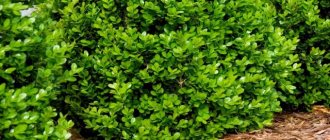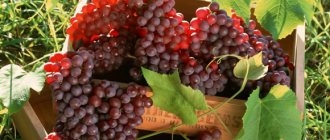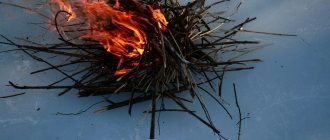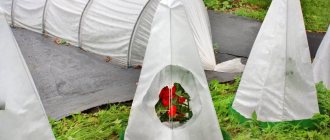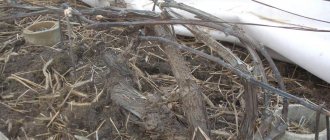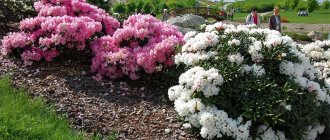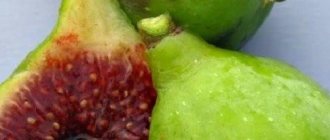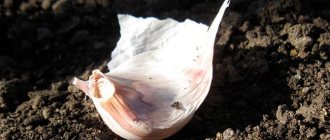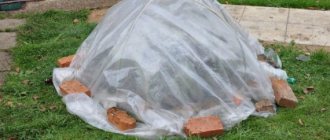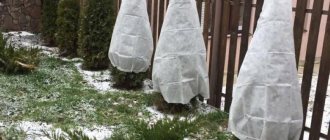Since mid-autumn, gardeners and summer residents have a question: what plants, when and what to cover for the winter. In central Russia, winters can be below minus thirty, so even some frost-resistant plants may need shelter at an early age, let alone roses, lilies, phlox, clematis and rhododendrons - they must be covered for winter.
So, why do plants need winter shelter:
- from freezing of the root system and shoots;
- from damage to plant trunks;
- from sunburn from the second half of winter;
- for protection against rodents.
The root system can freeze during frosts of minus 10 degrees, lasting more than 5 days in the absence of snow cover. First of all, this applies to those perennials that require mandatory shelter. Fruit seedlings and coniferous trees planted this year may also die for this reason.
During winter thaws and further severe frost, frost cracks can form on tree trunks. In order to prevent this unpleasant phenomenon, the trunks are covered with garden whitewash or covered with spruce branches.
Coniferous trees: thuja, juniper, spruce continue to evaporate moisture even in winter. But the root system in winter is not able to provide the plant with water. In addition, solar activity increases noticeably from February, thereby contributing to the occurrence of burns. Adult plants adapt to such influences, and young trees under 5 years of age need shelter from the sun at this time.
Rodents have little food left in winter, so they can gnaw the bark of fruit trees.
Pruning heuchera for the winter
Heuchera overwinters with its leaves. Only the flower stalks of this attractive plant are removed for the winter. With the arrival of the first frosts, they hill up the root collar and mulch the soil under the bushes with dry peat, humus and sphagnum. Closer to winter, when consistently frosty weather sets in, spruce branches are thrown onto the heuchera bushes.
- Heuchera in the garden - planting, growing and care
Do you want to grow heuchera with beautiful decorative leaves in your garden? This article will help you!
Covering materials of natural origin
Lapnik
Spruce branches are one of the most common and popular covering materials of natural origin. In addition to protecting plants from frost, it also protects them from sunburn and repels rodents with its thorny branches.
Lapnik is used:
- for covering winter crops, roses and heat-loving perennials;
- to protect seedlings from frost, rodents and sunburn;
- for snow retention.
However, spruce branches have their drawbacks:
- spruce needles increase soil acidity;
- with spruce branches you can introduce pests into the area - it is important that the corners are not red in color, do not have plaque or growths, it is also important to pay attention to the condition of the tree from which the branches were taken;
- The difficulty lies in the procurement of material - you can collect spruce branches only in clearings or from fallen trees in the forest, otherwise you can get a fine.
Dry leaves
Leaf litter can also be used to shelter plants from the cold. However, not all leaves are suitable for these purposes; they must be dry.
Don't use:
- leaves from fruit trees, because they are often the source of various diseases;
- birch leaves because they rot easily.
Disadvantages of dry foliage:
- difficulty in preparing and storing material;
- the leaves need protection from moisture, otherwise during the rainy season they stick together and form a dense mass that does not allow air to pass through; during the period of frost, the leaves turn into an ice crust, and when a thaw sets in, they perish;
- In spring, it is very difficult to remove the cover of leaves;
- leaves can be a source of disease, mold, mildew, pests, etc.
Considering all the disadvantages of dry foliage, it is usually used not as an independent and separate shelter, but as an integral part of some more complex insulating structure. For example, a hut made of boards was built over the plant, and a layer of foliage was laid on top, which was also covered with film.
Brushwood
Brushwood protects plants from frost and wind, and also helps to retain snow. Also among the advantages we can highlight the fact that brushwood does not rot, allows air to pass through and rots very slowly.
However, it does not hold heat well. Therefore, in snowless, frosty winters, such shelter is of little use.
Straw
Straw protects winter crops and perennials from frost, and also perfectly retains snow. However, only dry material can be used for shelter. Plus, the straw must be protected from moisture, otherwise it will begin to compact, cake and rot.
The main and most significant disadvantage of straw is that rodents like to nest in it. Also, do not forget that in the spring the ground under such cover does not thaw for a long time, so it is necessary to remove the straw quite early.
Sackcloth
It is customary to tie tree trunks with burlap, cover heat-loving plants and roses for the winter, and also shade and protect conifers from sunburn.
But, despite this, burlap is not without its drawbacks:
- it does not allow air to pass through well, so plants can damp out on it;
- allows and absorbs moisture, so such a shelter may well turn into an ice shell, which ultimately will not protect the plants, but will destroy them;
- Rot and mold can develop under damp burlap
- sometimes pathogenic microflora can develop on the tissue of the bag.
Sawdust
Sawdust can also be used to protect plants from frost, although you should not completely cover the plant with it. Use sawdust from clean wood to hill up or mulch the soil. But do not forget about the disadvantages of this material:
- sawdust must be protected from moisture, otherwise it will cake and rot;
- acidify the soil;
- In the spring, the ground under the sawdust takes much longer to thaw, so they should be removed as early as possible.
Peat
Peat can also be used to protect plants from frost, but only as mulch and for hilling. However, it should be remembered that peat:
- acidifies the soil, so it is not suitable for all plants;
- absorbs moisture well, which is why it can become compacted and lose its heat-insulating properties;
- When wet peat dries, it forms a hard crust; in principle, it is not difficult to destroy it; the main thing is to do it on time, otherwise it will harm the plants.
Autumn care for lavender in the open ground
Only English (narrow-leaved) lavender can overwinter in the ground. In autumn, the stems of the plant are shortened 3 cm above the woody shoot, the soil is mulched, and in early November they are covered with a thick layer of spruce branches. But even English lavender does not always survive the winter well, especially in some regions with an unstable climate. With the onset of cold weather, it is better to transplant this heat-loving plant into containers and move it to a heated veranda or winter garden. It is also worth doing with other types of lavender.
When to cover climbing roses in the Moscow region
The climate of the Moscow region is quite unpredictable. A warm, sunny autumn can unexpectedly end with September snowfall. That is why the preparation of roses for shelter for the winter begins here earlier than in the southern regions, and, accordingly, they are covered earlier too.
Typically, the time for work to cover garden beauties is at the end of October - beginning of November. But you need to carefully monitor changes in daily temperature. Roses are covered at a stable average daily temperature of -5-7˚C.
Caring for chrysanthemums in autumn and winter
To spend less time and effort preparing chrysanthemums for winter, plant flowers of zoned varieties. For example, varieties and hybrids of Korean chrysanthemum are best suited for the Moscow region. But these plants also need a winter coat.
Before the onset of frost, the above-ground part is cut to stumps 10 cm high, the base of the bushes is mounded with humus (10 cm layer), and mulched with dry peat on top of it. In a snowless winter, dry leaves are poured onto a layer of mulch, and then spruce branches are laid on them. If such a shelter does not save your chrysanthemums from freezing, dig them up, place them together with a lump of earth in a container and for the winter put it in a cellar with a temperature of 1 to 5 ° C.
We hope this article will help you maintain perennial plants even in harsh winters. And the attractive flowers will not disappoint you next season.
Preparing plants for winter
In addition to covering the plants, it is advisable to comprehensively prepare them for the winter. To do this, first of all, stop feeding plants with fertilizers containing nitrogen from the second half of August. Nitrogen promotes rapid growth of shoots, which is of no use to plants in winter. On the contrary, young shoots should have time to become covered with bark. At this time, the plants are fed with fertilizers containing potassium and phosphorus - these elements contribute to successful wintering. You can do both root and foliar feeding. Before the onset of stable frosts, coniferous plants need to be watered well.
Hilling them up (mulching) with dry peat or humus will be a good help for wintering fruit trees and shrubs. In winter, this will contribute to better protection of the root system, and in spring there will be less stagnation of melt water that will drain from such a hill. In addition, in the spring the plants will receive additional fertilizer.
Plants with long flexible stems: climbing roses, grapes, clematis are bent to the ground and secured with wire pins. Dry soil is poured on top.
Ordinary roses are pruned, leaving up to 6 buds, the leaves are removed and covered with peat or dry soil.
Feeding climbing roses in autumn
The process of preparing climbing roses for wintering in the Moscow region should begin in advance, back in July-August. From mid-summer, you should leave only potassium-phosphorus fertilizer (potassium chloride and sulfate, ammophos, potassium sulfate and others) and exclude nitrogen-containing fertilizer (ammonium and potassium nitrate, urea, azophosphate, etc.) - in order to prevent the formation of new shoots and start wood formation process.
To make the fertilizing procedure more effective, experienced gardeners combine applying fertilizers at the roots with spraying with fresh solutions from a spray bottle, because the leaves absorb useful substances just as well as the roots.
When to open climbing roses after winter
You need to remove the cover on time. Do not leave your pets in their shell for a long time in the spring: without fresh air in a humid environment, they will suffocate and get sick. In order to find out when to remove the cover from climbing roses, you need to focus on the condition of the soil. To do this, take a shovel and dig, if the shovel goes into the ground on a bayonet, then it’s time to remove the cover from the roses, the roses can already freely receive food. It is necessary not to skip the stage of removing covers from climbing roses, otherwise your roses may be banned. We remove the cover step by step - layer by layer, just as we covered it, so you can save your roses from spring frosts, there will be no severe frosts, but your rose will be covered with at least one of the covers. The last layer of cover will save your roses from drying out; they will be ventilated, but will still retain moisture. After removing the cover, place the branches on the support correctly: fasten them not vertically, but horizontally or in a spiral, obliquely. In this case, the fresh forces of the rose will be directed to the formation of flowers.
Every gardener should know all the ways to cover climbing roses for the winter in the Moscow region, so that the “queen of flowers” will delight you with her beauty for a long time!
Pruning climbing roses in autumn
Climbing rose, preparation for winter, autumn care. They grow into quite large plants and sheltering for the winter always causes a lot of inconvenience because of this, especially if the variety is very prickly. But there is no need to try to cut the rose at the root, just so that it can overwinter. The flower spent all summer on growing shoots, and next year, instead of blooming wildly, it will grow shoots again. This can cause the plant to become very weak and even die.
Climbing roses are usually pruned to one third of their height, no more. In addition, old shoots with dark bark, broken and young ones that do not have time to ripen by winter, are cut out. When pruning in autumn, you can shape the desired direction of growth, depending on how your rose grows, on a support or arch.
Which plants should be covered?
1. Plants with winter hardiness of USD 5 and above. These include:
- barberry;
- hydrangea;
- varieties of euonymus Fortune;
- deytsia rough;
- Lydian gorse;
- viburnum;
- St. John's wort;
- boxwood evergreen;
- weigela hybrida;
- the most graceful elm;
- Lydian gorse;
- cap honeysuckle;
- flowering calicanth;
- broom;
- snowberry;
- evergreen rhododendrons, etc.
2. All types of roses, except park roses.
3. All types and varieties of coniferous plants, they especially suffer from sunburn.
4. Plants planted this year that must undergo acclimatization.
